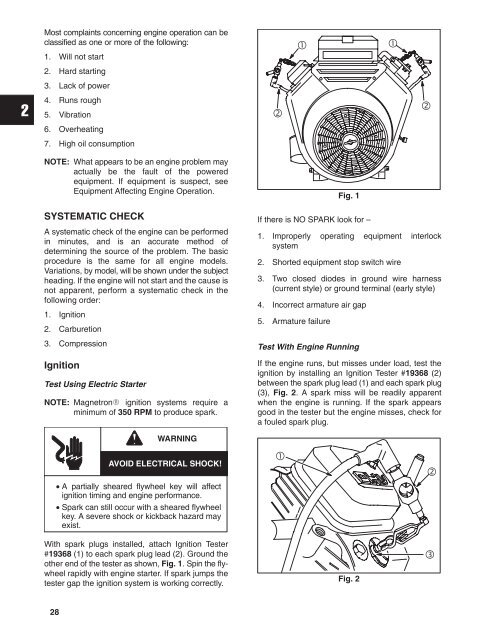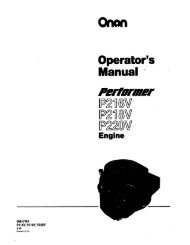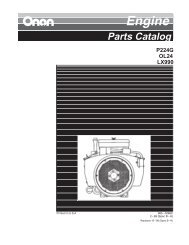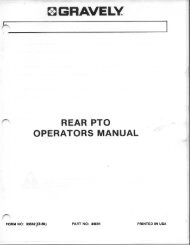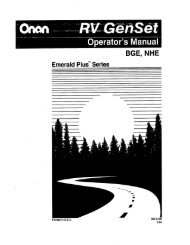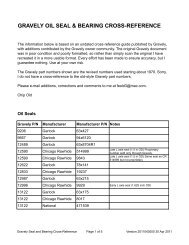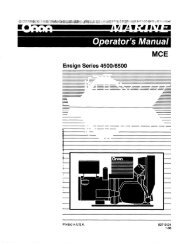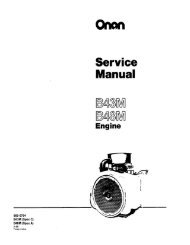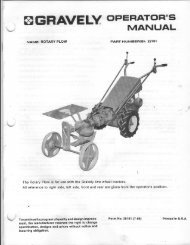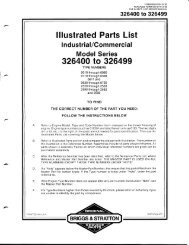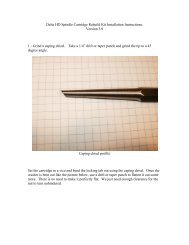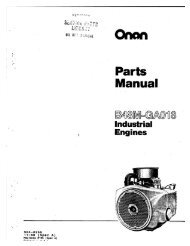272144 Vanguard Twin Cylinder OHV BRIGGS & STRATTON.pdf
272144 Vanguard Twin Cylinder OHV BRIGGS & STRATTON.pdf
272144 Vanguard Twin Cylinder OHV BRIGGS & STRATTON.pdf
Create successful ePaper yourself
Turn your PDF publications into a flip-book with our unique Google optimized e-Paper software.
Most complaints concerning engine operation can be<br />
classified as one or more of the following:<br />
1. Will not start<br />
2. Hard starting<br />
3. Lack of power<br />
<br />
<br />
4. Runs rough<br />
5. Vibration<br />
6. Overheating<br />
7. High oil consumption<br />
<br />
<br />
NOTE: What appears to be an engine problem may<br />
actually be the fault of the powered<br />
equipment. If equipment is suspect, see<br />
Equipment Affecting Engine Operation.<br />
SYSTEMATIC CHECK<br />
A systematic check of the engine can be performed<br />
in minutes, and is an accurate method of<br />
determining the source of the problem. The basic<br />
procedure is the same for all engine models.<br />
Variations, by model, will be shown under the subject<br />
heading. If the engine will not start and the cause is<br />
not apparent, perform a systematic check in the<br />
following order:<br />
1. Ignition<br />
2. Carburetion<br />
3. Compression<br />
Ignition<br />
Test Using Electric Starter<br />
NOTE: Magnetron ignition systems require a<br />
minimum of 350 RPM to produce spark.<br />
Fig. 1<br />
If there is NO SPARK look for –<br />
1. Improperly operating equipment interlock<br />
system<br />
2. Shorted equipment stop switch wire<br />
3. Two closed diodes in ground wire harness<br />
(current style) or ground terminal (early style)<br />
4. Incorrect armature air gap<br />
5. Armature failure<br />
Test With Engine Running<br />
If the engine runs, but misses under load, test the<br />
ignition by installing an Ignition Tester #19368 (2)<br />
between the spark plug lead (1) and each spark plug<br />
(3), Fig. 2. A spark miss will be readily apparent<br />
when the engine is running. If the spark appears<br />
good in the tester but the engine misses, check for<br />
a fouled spark plug.<br />
WARNING<br />
AVOID ELECTRICAL SHOCK!<br />
• A partially sheared flywheel key will affect<br />
ignition timing and engine performance.<br />
• Spark can still occur with a sheared flywheel<br />
key. A severe shock or kickback hazard may<br />
exist.<br />
<br />
<br />
With spark plugs installed, attach Ignition Tester<br />
#19368 (1) to each spark plug lead (2). Ground the<br />
other end of the tester as shown, Fig. 1. Spin the flywheel<br />
rapidly with engine starter. If spark jumps the<br />
tester gap the ignition system is working correctly.<br />
Fig. 2<br />
<br />
28


